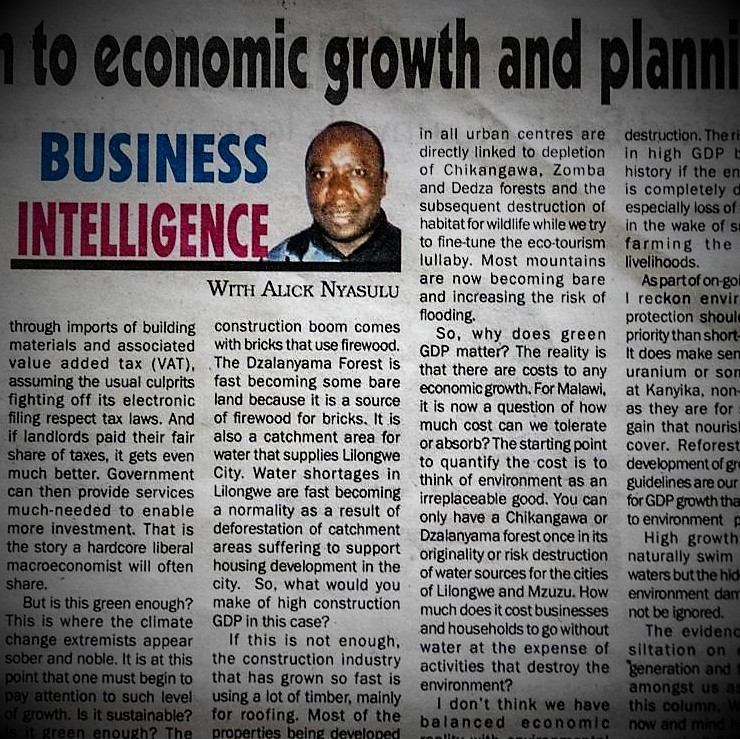
Never mind the rhetoric that comes from climate change extremist but it helps to pay attention to some of their utterances. I do, and like many others in the economic profession, agree that gross domestic product (GDP) is just some number that falls short of telling the truth about the quality of life for the average person. While numbers don’t lie, it is a fact that they can mislead. There are a lot of hidden costs that come with economic activity and lead to development that is destructive to the environment.
Now let us start by paying attention to some of the environmental risks. Our economic growth has generally been high, number wise but there is some serious soul-searching. Recent floods just motivate the docile mind in me to take a new picture.
In 1998, the city of Lilongwe had a population of slightly above half a million. Within a decade, it had risen to over a million. It has exceeded Blantyre City. Blantyre too has risen and edging closer to a million. Mzuzu is rising fast. There is a rapid wave of urbanisation.
The rapid growth of Lilongwe has led to a high demand for housing, and its rentals, like its population growth have risen annoyingly. If you look at the overall picture, population of the country is fast rising. This has serious implications on our GDP if our economic activities are viewed with a sustainability eye.
Consider the massive construction that has taken place in main cities to meet the high demand for housing. From a strict economic view, the benefits are clear. Jobs, predominantly in the informal sector have been created. Think of communities that sell bricks, casual labourers at construction sites. It is all part of economic activity that is contributing to GDP. It leads to high growth, and sometimes jobs are created. Taxes are paid to government through imports of building materials and associated value added tax (VAT), assuming the usual culprits fighting off its electronic filing respect tax laws. And if landlords paid their fair share of taxes, it gets even much better. Government can then provide services much-needed to enable more investment. That is the story a hardcore liberal macroeconomist will often share.
But is this green enough? This is where the climate change extremists appear sober and noble. It is at this point that one must begin to pay attention to such level of growth. Is it sustainable? Is it green enough? The construction boom comes with bricks that use firewood. The Dzalanyama Forest is fast becoming some bare land because it is a source of firewood for bricks. It is also a catchment area for water that supplies Lilongwe City. Water shortages in Lilongwe are fast becoming a normality as a result of deforestation of catchment areas suffering to support housing development in the city. So, what would you make of high construction GDP in this case?
If this is not enough, the construction industry that has grown so fast is using a lot of timber, mainly for roofing. Most of the properties being developed in all urban centres are directly linked to depletion of Chikangawa, Zomba and Dedza forests and the subsequent destruction of habitat for wildlife while we try to fine-tune the eco-tourism lullaby. Most mountains are now becoming bare and increasing the risk of flooding.
So, why does green GDP matter? The reality is that there are costs to any economic growth. For Malawi, it is now a question of how much cost can we tolerate or absorb? The starting point to quantify the cost is to think of environment as an irreplaceable good. You can only have a Chikangawa or Dzalanyama forest once in its originality or risk destruction of water sources for the cities of Lilongwe and Mzuzu. How much does it cost businesses and households to go without water at the expense of activities that destroy the environment?
I don’t think we have balanced economic reality with environmental destruction. The risk remains in high GDP becoming history if the environment is completely destroyed, especially loss of farm lands in the wake of subsistence farming the core of livelihoods.
As part of on-going reforms, I reckon environmental protection should be a key priority than short-term gains. It does make sense to mine uranium or some metals at Kanyika, non-renewable as they are for short-term gain that nourishes import cover. Reforestation and development of green building guidelines are our imperatives for GDP growth that is sensitive to environment protection.
High growth numbers naturally swim in sensual waters but the hidden costs of environment damage should not be ignored.
The evidence of river siltation on electricity generation and flooding are amongst us as you read this column. Why not act now and mind how we grow economically?
